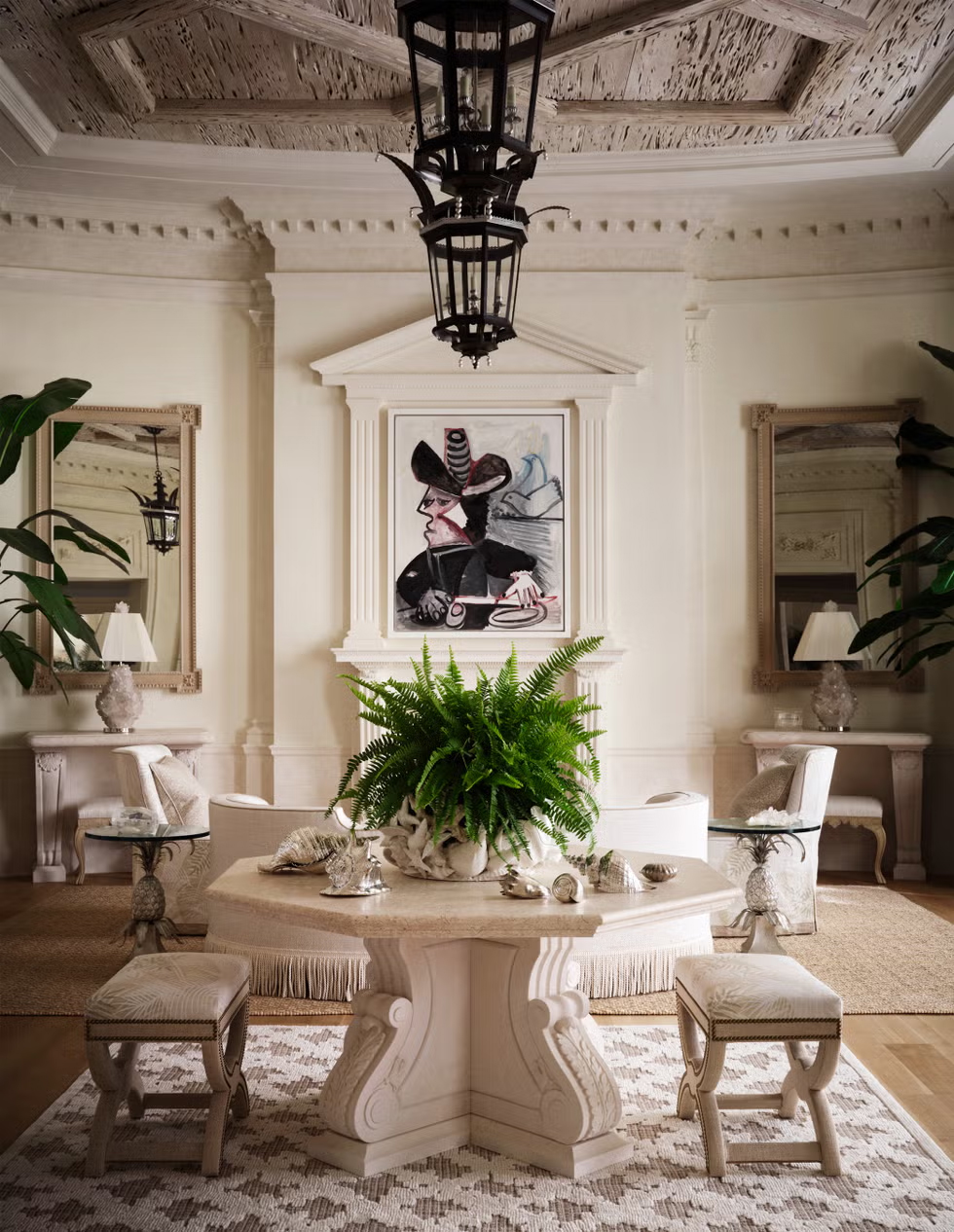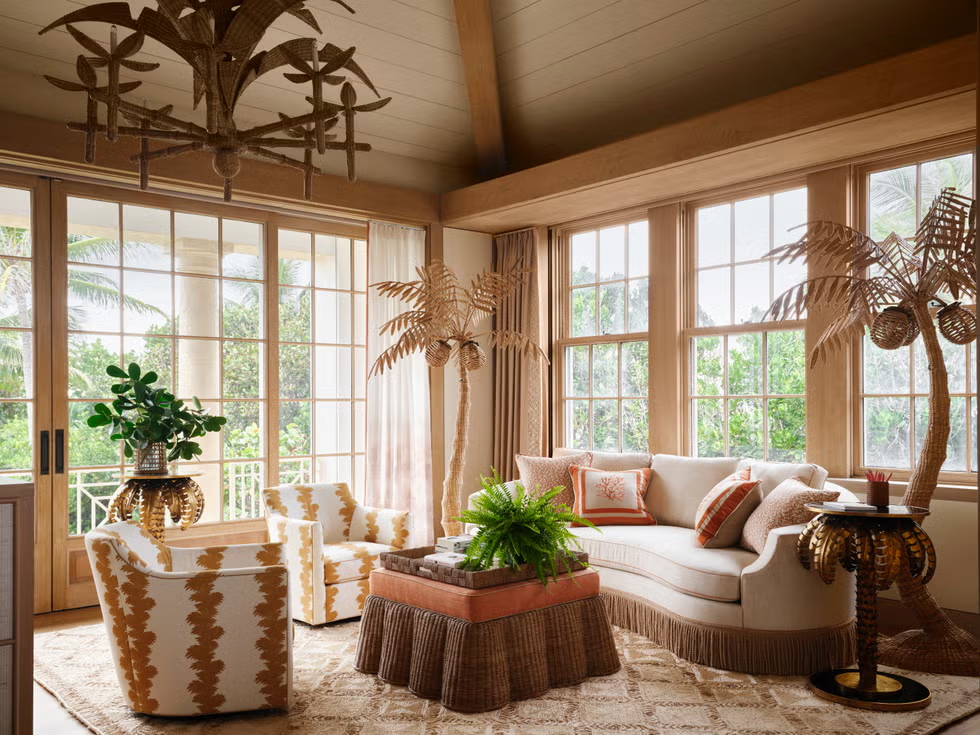Palm Beach isn’t really a “before you leave the house, take off one thing” kind of town.
If local style can be subtle, this is it.
To get to Tommy and Dee Ocleppo Hilfiger’s newly renovated property in Palm Beach, turn right at Mar-a-Lago, pass the blinking police lights, then scoot a bit farther on South Ocean Boulevard down Billionaires Row. Behind a gate and across a crunchy white pebble driveway, a shell and tangled coral sculpture carved in coquina stone hangs over the entrance to Coral House. Tommy and Dee, at the door, are in their Saturday casuals, he in a blue shirt and print shorts, she in a Johanna Ortiz print shift dress with tassels. They are barefoot—it’s a shoes-off household. Slippers are offered.
Behind them is an atrium with a wide staircase that delivers us to the main living floor in the house, which was once owned by the disgraced media magnate Conrad Black. Not surprisingly, one of America’s most successful fashion designers has an exacting eye, including a thing about symmetry.
One of Tommy’s first decisions was to rip out the winder stairs and install steps that float up to a central hall with a ceiling of pecky cypress, walls waxed and glazed in a limestone color, and bespoke curtains in subdued hues. In the adjoining living room are glass tables with pineapple sculpture bases and English Regency dolphin chairs, both painted gray-white.

Picasso’s Mousquetaire aux Oiseaux (1972) in the living room. Designer Cindy Rinfret conceived the pecky cypress ceiling and SuperStrata artisan Patrick Shoemaker finished the walls in birch bark faux bois.
“You don’t walk in and go, ‘Oh, coral!’ I don’t like it when the dress wears the girl,” says Cindy Rinfret, the Greenwich and Palm Beach–based interior designer who has worked with Hilfiger on 18 other projects. “Tommy calls this his grand performance.”
Like their friends Jon Bon Jovi and Sylvester Stallone, the Hilfigers are now Florida residents. For card-carrying members of the “six months and a day” set, second homes are becoming first homes. This permanence means a lot coming from someone who buys new houses the way others replace AirPods.

In the upper loggia, Warhol’s Flowers (1964). The lantern is by Charles Edwards, and the rug is a custom abaca from Patterson Flynn.
“We sold Connecticut, we sold New York. We had one in the Hamptons we sold. We bought one in Aspen and sold it within a short amount of time,” Tommy says. These houses will be preserved in a book, Hilfiger Homes, coming out in 2025, which also marks the 40th anniversary of his label.
Another house in Palm Beach, which they sold in 2018 to the Russian banker Vladimir Stolyarenko, has fallen into disrepair. “I wish we could buy it back,” Hilfiger says. For a time they had been living in interim residences and hotels while they were looking, and during the renovation. “I had a toaster from Target in my bedroom,” Dee says.

A Rinfret-designed trellis installed by Accents of France stands out against de Gournay wallpaper. Hickory Chair Chippendales line a vintage mirror table set with Dee Occlepo Hilfiger’s personal tableware collection.
Leaving their Connecticut home was emotional. They had been there for 12 years, and it was where they raised their now 15-year-old son, Sebastian, who attends school in Palm Beach. “I thought it was our forever home,” Hilfiger says, but then Covid happened and, as for everyone else, it shifted their perceptions of work, commuting, and the meaning of the word zoom. Tommy was also ready for a shift. “I don’t like to go back. I like to go forward.”
“But I think I’m gonna start to put my foot down after 20 years of marriage,” Dee chimes in. “I’m not ready to move for a while.”
For the most part, they agree on matters of style and design. “There was this thing Tommy did when we started dating,” says Dee, a designer herself with her own accessories brand. “He’d pick a page in a magazine, and there would be 10 things, and he’d ask, ‘Which one are you gonna pick? Which chair do you like? Which pair of sunglasses do you like?’ I’d pick, and he’d be like, ‘That’s the same one I like!’ I think you finally decided to marry me because we have the same taste,” she says, smiling.

To satisfy Dee’s request for a blue room, Rinfret designed an indigo palm motif on Gracie wallpaper for one of the guestrooms.
Coral House, built in 1972, was designed by John Volk, one of the Big Five architects who created the Palm Beach look. It has a Mediterranean-style macaroni shape that embraces a pool and patio area that overlooks the Intracoastal Waterway. Until 2011 the property belonged to Black, the British-Canadian newspaper tycoon who was convicted of fraud charges in 2001 and was later pardoned by President Donald Trump.
“When Conrad Black owned it, it was elegant,” Dee says, but subsequent owners made unfortunate renovations. “It looked like a restaurant in Croatia,” she says of the atrium.
Today the ground floor includes three guest bedrooms, a theater, a gym, a spa, and Tommy’s office; most of the family spaces are on the second floor. Past the central hall and living room are masc/femme-identified powder rooms, one cream, one pink, with walls lined in crushed shell mosaics, as well as small Greco-Roman busts festooned with shells, made by local artisan Christa’s South Seashells.

In a first floor guest bedroom, the canopy bed from Palm Beach Living is made with Lori Jayne linens. The wall covering is Osborne & Little.
Down the hall from the living room, a serene blue guestroom lined in Gracie wallpaper with indigo palms is where Dee’s bestie Kris Jenner stays when she’s here. (She gave them a contraption that puts various milk foam designs on your coffee. It’s in the kitchen.) Dee’s Deborah Vance in Hacks moment is an immaculate dish room, where she can keep her collection of china and silver, including mother-of-pearl-handled cutlery elegantly poised, like Ocleppo herself, for all tomorrow’s parties.
So far, though, the dinner parties have been small (Tom Ford, a new neighbor, and Jeff Bezos were recent guests), and getting the kids together at one time is a challenge. “We have three in L.A., one in New Haven in school, two in Italy,” Tommy says. Big gatherings happen down at their summer villa. “Mustique is like a mini hotel,” says Dee.

In the sitting room of the primary bedroom, the raffia chandelier and floor lamps are from Circa Who. Natural light pours in from both the Intracoastal Waterway and the Atlantic Ocean.
Past the upper loggia is the fully stocked Coral Bar, a chandelier of gold and glass palm trees, and lacquered walls topped with bamboo piping. This is where you might get tipsy with Tom and Jon and Sly as someone toasts, “To a life well-lived!” The Hilfigers know something about that.

One of Tommy’s three closets painted “Hermès Orange”. The vintage footrest is from Louis Vuitton.

Dee’s bathroom is illuminated by a silver chandelier she acquired in Paris. Draw sheer curtains and take a relaxing bath in the marble bathtub.
In Tommy’s office, a copy of his 2016 memoir, American Dreamer, rests on a table. In it Tommy describes growing up in a huge family, with undiagnosed dyslexia and a disapproving, often angry father. “I was immersed in negativity as a child and couldn’t wait to get out and be positive about everything,” he writes. It’s not a pose for him, positivity—something you can’t really manufacture. That spirit emanates from his home, and, still, decades and hundreds of runway shows later, from the man himself.
(Photo at top: Tommy Hilfiger and Dee Ocleppo Hilfiger, whose home faces the Intracoastal Waterway, on a vintage Rolls Royce from Tommy’s car collection. Landscape architecture is by Mario Nievera)
This story appears in the December 2024/January 2025 issue of Town & Country, with the headline “Wake Up and Smell the Palm Trees.”
